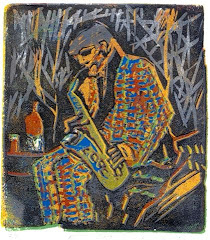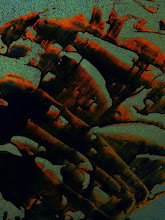From ArtDaily.org:
Philadelphia is the Only Venue for a Major Exhibition Exploring Cézanne's Impact on Artists
Henri Matisse, (French, 1869 – 1954), Fruit, Flowers, and The Dance, 1909. Oil on canvas, 35 x 45 5/8 inches. The State Hermitage Museum, St. Petersburg. © 2009 Succession H. Matisse / Artists Rights Society (ARS), New York.
PHILADELPHIA, PA.- In 1907, the French painter Paul Cézanne’s posthumous retrospective astonished younger artists, accelerating the experimentation of European modernism. Cézanne (1839-1906) became for Henri Matisse “a benevolent god of painting,” and for Pablo Picasso “my one and only master.” Cézanne’s inclusion in the Armory Show in New York in 1913 also offered American artists a new direction. Cézanne & Beyond (February 26 through May 17, 2009) will examine the seismic shift provoked by this pivotal figure, examining him as form-giver, catalyst, and touchstone for artists who followed. It will survey the development of an artistic vision that anticipated Cubism and fueled a succession of artistic movements, and will juxtapose Cézanne’s achievement with works by many who were inspired directly by him, showing a fluid interchange of form and ideas. It will place his work in context with more recent artists like Ellsworth Kelly, Jasper Johns, and Brice Marden, who in quite different ways came to terms with the master of Aix-en-Provence. His profound impact on successive generations endures to the present day. The exhibition will present more than 150 works, including a large group of paintings, watercolors and drawings by Cézanne, along with those of 18 later artists.
The artists included, in chronological order, are Henri Matisse, Piet Mondrian, Marsden Hartley, Fernand Léger, Pablo Picasso, Georges Braque, Charles Demuth, Max Beckmann, Liubov Popova, Giorgio Morandi, Alberto Giacometti, Arshile Gorky, Ellsworth Kelly, Jasper Johns, Brice Marden, and Jeff Wall, Sherrie Levine, and Francis Alÿs.
The exhibition is organized by Joseph J. Rishel, The Gisela and Dennis Alter Curator of European Painting before 1900, in collaboration with Philadelphia Museum of Art colleagues, including the late Director Anne d’Harnoncourt, and Kathy Sachs, Adjunct Curator, Michael Taylor, The Muriel and Philip Berman Curator of Modern Art, and Carlos Basualdo, The Keith L. and Katherine Sachs Curator of Contemporary Art. They are joined by a group of international scholars who have both advised on the selection and contributed to the catalogue. “The exhibition is about the pleasures of experiencing the interaction of artistic ideas in a creative dialogue across a continuum,” Rishel said. “The installation will juxtapose works from the past and present, with Cézanne as the generative pivot. Rather than charting a chronology of influence, we are especially interested in examining artistic ideas in motion, extended, reformulated, and transmuted by the hands of different artists. I’d like to think that the viewer will be able to experience it in a completely non-linear way, always circling around to Cézanne.”
All of the artists in the exhibition have acknowledged Cézanne’s profound impact on their work. When Henri Matisse (1869-1954) donated his Cézanne painting of Three Bathers to the Petit Palais in 1936, he wrote: “in the 37 years I have owned this canvas, I have come to know it quite well, though not entirely, I hope; it has sustained me morally in the critical moments of my venture as an artist; I have drawn from it my faith and my perseverance…” Picasso (1881-1973) in his long and varied artistic career often used Cézanne as a lever in his critical shifts, from his Self-Portrait with Palette, through to the lyricism of La Rêve, and onto his later examination of bathing subjects both as painting and sculpture. Braque, who with Picasso used Cézanne as his principle touchstone early on, spent time at several of Cézanne’s painting locations. For him “it was more than an influence, it was an initiation.”
Piet Mondrian (1872-1944), who was drawn especially to the formal structure achieved by Cézanne, brings an analysis of Cézanne to an abstract conclusion, as reflected in his own words “... that beauty in art is created not by the objects of representation, but by the relationships of line and color.” “Cézanne taught me the love of form and volumes,” Fernand Léger (1881-1955) once remarked, and “the power of Cézanne was such that, to find myself, I had to go to the limits of abstraction.” In Russia, Liubov Popova (1889-1924) discovered Cézanne in the Moscow collections of Morosov and Shchukin and drew from him the pleasures of geometric fragmentation, which swiftly moved to pure abstraction.
In the United States, as modernism gathered force, members of the Stieglitz circle, especially Charles Demuth (1883-1935) and Marsden Hartley (1877-1943), became fascinated with Cézanne. Demuth’s still life compositions in particular show a deep connection to Cézanne’s bold late watercolors. In his autobiography, Hartley noted that Cézanne offered “ideas that were to make the world of painting over again and give modernism its next powerful start,” adding that “there is no modern picture that has not somehow or other been built upon these new principles.” Arshile Gorky (1904-1948) studied Cézanne closely, and the exhibition reflects his keen engagement with Cézanne’s style, especially in the mid to late-1920s. Gorky affectionately referred to the French artist as “Papa Cézanne” and even in his later abstractions there is a profound sense of the lesson of Cézanne.
Later, looking back on his career, Max Beckmann said: “my greatest love already in 1903 was Cézanne.” He “revere[d] Cézanne as a genius” throughout his life, looking particularly at the dark, emotional early works and the heavy black outlining of some of Cézanne’s figures. In Italy, Giorgio Morandi (1890-1964) first saw Cézanne images in books in 1909 and then in person in exhibitions in Venice and Rome. His path as an artist of both still lifes and landscapes was set. Alberto Giacometti (1901-1966) was introduced to Cézanne by his painter father, but had to wait until the Venice Biennale of 1920 to see his work face-to-face. For him the attraction was the sense of process rather than arrival. Cézanne is firmly linked to an existential sense of doubt and anxiety that permeates Giacometti’s explorations of objects and people in space through two or three dimensions.
In this sense Giacometti is akin to Jasper Johns (b. 1930), for whom Cézanne has been a continuous point of reference and has served over the years as a sort of eminence. The exhibition presents numerous works by Johns that make overt and oblique references to Cézanne, including drawings inspired by Cézanne’s bathers and paintings of figures that are referenced in Johns through such works as the Seasons and In the Studio. Ellsworth Kelly (b. 1923) first discovered Cézanne as a student in Boston and is quick to explain that Cézanne is often at play in his art making. Kelly’s exploration of the relationships between form and color, figure and ground, take on an immediacy and constancy for our understanding of both artists. Brice Marden (b. 1938) commented “that Cézanne almost made the perfect painting.” In Marden’s own works, Cézanne’s pursuit of an essentially unobtainable goal of distillation, often through repetitions on the same motif, is a shared journey.
The exhibition places substantial emphasis on artists of the present day, including long established masters such as Kelly, Johns, Marden, and Jeff Wall (b.1946), and younger artists responding to the idea of the show such as Francis Alÿs and Sherrie Levine. Wall’s magnificent light box photographs show that Cézanne’s influence transcends the medium of painting. While working in an entirely different medium, the photographer Wall is a life long admirer of Cézanne either through direct quotations or more often through implied transgressive references.
“Our purpose is first to display the continuing vitality of Cézanne as an artistic resource five generations on,” added Rishel. “Of equal importance in our endeavor is to illustrate the unfolding reality that a different Cézanne has evolved for each generation, defined by what artists have made of him and passed along to those who came after. It is a continuing story.”
During the preparation for the exhibition, Anne d’Harnoncourt, the Museum’s late Director, said: “Cézanne is a rare artist whose work touched so many artists and contributed to shape a broad spectrum of talents and who, remarkably, continues to find fresh resonance today. Philadelphia, like Aix, has long been a major destination for Cézanne lovers because the Museum and the Barnes Foundation hold such comprehensive collections of his work. This exhibition presents an opportunity to fully appreciate both Cézanne’s art and its impact over time, offering visitors the experience of participating in the extraordinary conversation among artists that has engaged many of the major talents of the last century.”
Merry Christmas From Hyperallergic
6 hours ago
























![Paranoia, Self Destroya [close up]](https://blogger.googleusercontent.com/img/b/R29vZ2xl/AVvXsEhBVxAxErt2JEcog1e4P0LQ7GaNtG2OHRtXbpU9LZt4shZeR9-s_5uPcuo2ogc99mywHRaOgifZeu7rvyC5ESW03FO2kButf6A5MIaKH1qIkfHPeeRY_7eYOxRvwPuuAqhlNX0kOI1QO0g/s220/IMG_0415.JPG)

No comments:
Post a Comment